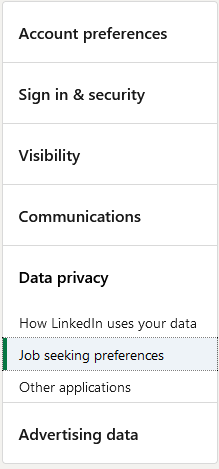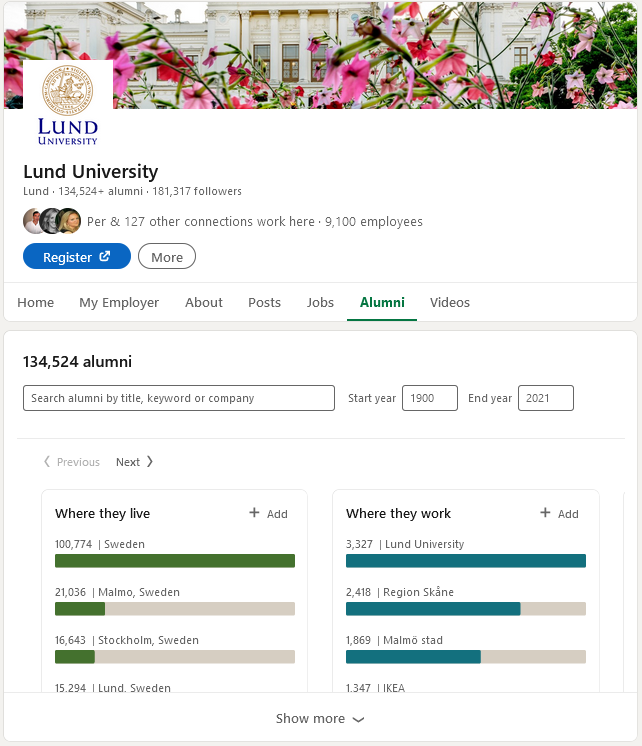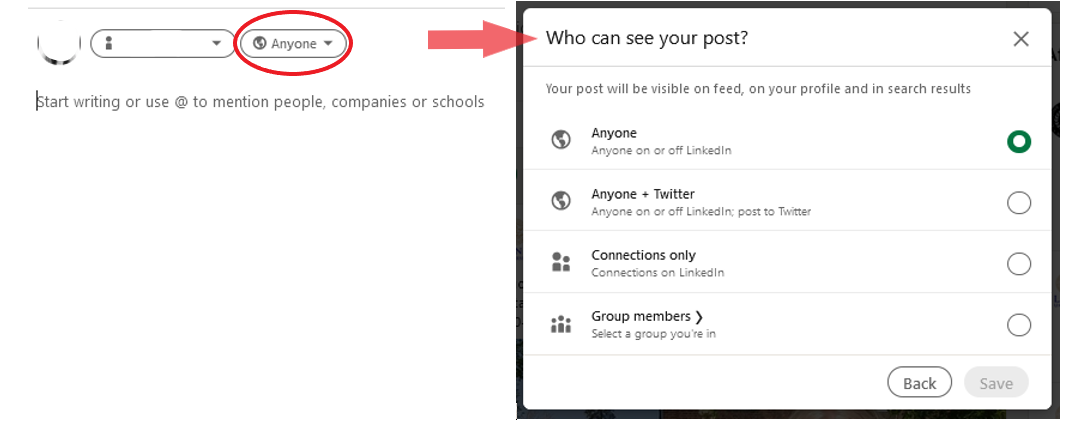Perhaps you have fine-tuned your profile, made some connections and even started following some companies of interest. If you’re on the job hunt or simply want to improve your LinkedIn network, we’ve got some tips for you! Based on the content of our latest webinar on 10 February with certified CV expert, Birgitta Möller, we will give you some pointers to help you expand your network and enhance your presence on LinkedIn.
Bonus: Everything we mention can be done with a free account. LinkedIn Premium has its extra perks, but it’s not necessary for having a good profile and being an active networker.
When networking on LinkedIn, it’s important to think about what kind of impression you want to make. Think about how you want to come across when sharing content and connecting with others. Keep in mind your purpose on LinkedIn – why do you want to be there and what kind of people do you want to connect with? This will help guide you as you become more active on LinkedIn.
The basics
In order to enhance your networking efforts and the impact of the content you share, here are some things to consider.
Have a good profile photo | |
Have a clear and descriptive headline | |
Have an informative and interest-catching “About” section | |
Maintain and up-to-date skills list |
Pro tip: Pin your top 3 skills for which you want to be known. Because you can only pin 3, choose the 3 that you really want to make sure that people see. This is more important than choosing the ones with the most endorsements.
Keep your profile updated. Make changes now and then or fine-tune the wording. Recruiters filter profiles based on how active they are and profile updates factor in to activity levels.
Review your “Settings and privacy”
Depending on your own preferences and how visible you want to be, make sure you’ve adjusted your settings accordingly. Your preferred settings may vary over time, so adjust as needed while getting more comfortable in your “LinkedIn shoes.”
VISIBILITY
Here, you can adjust your profile viewing options. You can also edit your public profile and decide how it will look for others. You can toggle options of what you want others to be able to see or not see when looking at your profile.
You can also decide who can see or download your email address. The default is that only 1st degree connections can see your email address. However, this could be disadvantageous if you’re on the job hunt. Birgitta recommends changing this so your 2nd degree connections can see your email. This way, you increase the chances of a recruiter being able to email you if they are looking at your profile.
 COMMUNICATIONS
COMMUNICATIONS
Here, you can manage your notifications and who can reach you. Review your options and adjust according to your preference.
DATA PRIVACY & JOB SEEKING PREFERENCES
There are quite a few settings you can adjust in regards to your job seeking preferences on LinkedIn. Go through these options and adjust as needed. This is a great way to send a signal of interest to recruiters.
Making connections
Now that you’ve adjusted your settings, let’s start making connections!
Sending connect requests
There is a way to do this and a way NOT to do this. We cannot emphasise this enough – always include a personal note when sending a connect request! This is especially important for any requests you want to send to someone who isn’t already a very close friend of yours. LinkedIn is a platform that encourages networking with strangers, but you have to provide some reasoning as to why you want to connect with someone, especially if you’ve never met face-to-face.
Make a good first impression and add a note!
Unfortunately, LinkedIn makes it too easy to send connect requests that do not include a note. So here comes the important tip – first go to the person’s profile and then click on the “Connect” button from their profile. When taking this route, you are presented with the option to add a note (max 300 characters, including spaces). We also suggest sending connect requests on a desktop because the mobile app does not have the option to add a note.

Find things you have in common with the person. It could be that you both studied at the same university or have worked at the same company, or perhaps you have some mutual connections. Or, maybe you recently heard the person give a presentation or you’ve read a book/article written them. Incorporate these commonalities or interests into your note to give some backstory as to why you want to connect.
Example:
“Hi! I came across your name while looking for an expert within [fill in the blank]. I have recently graduated from Lund University with a degree/interest in [fill in the blank]. I can see that we have 4 connections in common and [Name of one of those connections] is one of my good friends, so it would be great to also have you in my network here on LinkedIn.
Best regards from Southern Sweden”
Adding personal details and showing your reasoning for wanting to connect leads to a higher likelihood that the person will accept your connect request.
If you don’t want to connect (or at least not yet), you can instead opt to follow. When following, you get their posts in your feed. You can always unfollow if you no longer want to network with this person.
Networking with companies and employers
You can also follow companies at which you’re interested in working. When actively job-hunting here are some tips on how to engage with recruiters:
Start by following the companies in which you’re interested.
Find HR reps or relevant employees at these companies and connect or follow them.
After following them for a while, so you get a feel for the company, comment on their content and/or compose a well-crafted note with a reason as to why you want to connect with them and have them in your network
Q: If you’ve gone on an interview but the recruitment process is still active, is it appropriate to connect with the interviewer on LinkedIn?
A: If you want to connect with this person, perhaps bring that up at the end of the interview. Ask if it would be ok to connect on LinkedIn. This shows that you are someone who is interested in that job or other potential jobs at the company, but it also allows the interviewer to reply with an alternative way to stay in touch if they prefer not to connect on LinkedIn.
Search tools on LinkedIn
LinkedIn is a huge database, so utilise the search tools available to you. For example, you can search for key words “HR manager” and then filter by “People” and then by “Connections – 2nd degree” and then by “Current company” and so on. This is a great way to find new potential connections. You can also search based on hashtags or you can try different filters (such as locations, groups, etc.).

Your 2nd degree connections are perhaps the most valuable! With every 1st degree connection, your pool of 2nd degree connections grows and the networking potential is great.
Example note for a connect request to a recruiter:
“Hi [Name], I was looking for someone at [Company XYZ] and noticed you also know [Name of mutual connection]. I’m keen to learn more about [fill in the blank] …”
The alumni search tool is also a great way to network with fellow alumni. From the Lund University page, you can find the “Alumni” tab where you are presented with a variety of search filters and an option for a keyword search.

Your search results will display a list of profile previews (including a “Connect” button). However, remember to always go to their profile and click “Connect” there so you can add your personal note.
Warning: If you click the “Connect” button displayed on a list of profiles (e.g. search results or the “People you may know” list), a request is immediately sent with no personal note.
Search for people, companies or groups that can add value to your network and start following and/or connecting!
Your LinkedIn presence
In order to be seen as an active member in any network, you have to also contribute to the network. Networking is a give and take relationship. So how can you do this on LinkedIn, you may ask? Write original posts, comment and share content while adding your own thoughts and questions.
♦ Do you have an “All Star” profile? If so, this makes your content have 1 ½ times more success. View the dashboard on your profile to see if you have the “All Star” icon.
Create content
Writing a post on LinkedIn works pretty much the same as on other social media platforms. Photos and videos usually get better visibility and engagement. If you post a video, make sure it has subtitles and is no longer than one minute (30-60 seconds is usually good).
Give the first sentence in your post some extra thought so you entice the reader to want to click “…see more” and read the rest of your post. Consider what is interesting and relevant for those in your network. Your posts could provide tips, inform or educate on a specific topic, or you could share industry news and trends. Ask questions to your network in order to engage with them, and if they comment on your post or article, write a reply comment.
Utilise hashtags and tag connections and companies, when appropriate.
You can also choose who can see your post. Maybe you want it visible for anyone or you just want to share it with group members. You have options!

You can always edit or delete your posts so try experimenting and see what works best in your network and amongst your connections.
When to post
Mornings (6-10 am) or around noon are the best times of day to post. Afternoons and evenings are not as active. But again, test the waters with your network and see what seems to work best.
When you publish a post, LinkedIn will send the post to 2-6% of your connections. The number of connections you have, and how many people engage with your post, will impact how far your content will travel.
Tip: LinkedIn doesn’t show more than 2 posts from the same person in members’ feeds, so don’t post too often as it won’t reach your audience. Posting 1-2 times per week is good.
Engaging with content
Commenting makes a difference and helps rank your post higher. Replying to comments can also help enhance your content. Liking a post or comment does not do much for you, whereas commenting makes a bigger impact.
Simple or standardised comments like “Congrats on the new job” (especially to a connection you don’t know that well) aren’t all that meaningful. It is better to make a more substantial comment. For example, you could comment on something you recently read – “I read about that company… [describe some new thing going on or interesting anecdote]. Sounds interesting! Best of luck at the new job!” If you want to get noticed, revolve your comment around something more than just a simple congrats.
Being on LinkedIn on a regular basis (at least once a week) keeps you active and present within your network.
Fun fact: Did you know that being active on a regular basis can actually be more important than having a perfect profile?
Recommendations
They are good have and good to give! However, avoid purely exchanging recommendations. This can devalue your recommendations because it ends up looking like you just did each other a favour. Instead, write unique recommendations.
Recommendations are taken more seriously than endorsements. However, make sure it’s about something substantial. What did you do? What were the circumstances? What were the outcomes? Why was this person good at it? And so on.
If you’d like to ask someone in particular to write a recommendation for you, you could call on the phone or write an email and explain that you’re becoming more active on LinkedIn and would appreciate a recommendation. You could even provide some bullet points highlighting a certain project you worked on or skills you developed, and mention that you’d really appreciate it if they could include those points.
People like to help out, and there is often no harm in asking for help.
It all comes down to being courteous, composing unique comments, writing nice personalised messages when wanting to connect and doing a good bit of research to find common topics of interest. And remember to return the favour and offer help to others in your network.
Additional tips & guides
Read previous articles about LinkedIn by clicking on the titles below:
How to become a LinkedIn Pro
When having a good LinkedIn profile is not enough…
LinkedIn guide: Optimize your career opportunities
Keeping up with the LinkedIn profile
Try out your networking skills with LU alumni in the Alumni Network group on LinkedIn
Get your SSI (Social Selling Index) score
This shows you how good are you at using LinkedIn.


